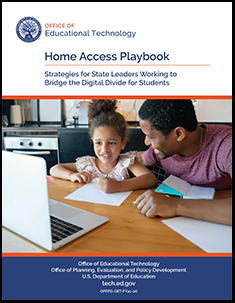Featured Publications

Home Access Playbook
In spring 2020, the Office of Educational Technology (OET) hosted a series of listening sessions with state leaders—from state educational agencies (SEAs), state broadband offices, state libraries, and state economic development agencies—to identify what digital equity issues were magnified as a result of school closings, what immediate actions states were taking to address these issues, and what long-term solutions were being considered to sustainably address these issues.

Wireless Brief
Preparing students to be successful for the future requires a robust and flexible learning infrastructure capable of supporting new types of engagement and providing ubiquitous access to the technology tools that allow students to create, design, and explore.
Digital Equity Education Roundtables (DEER)
The Bipartisan Infrastructure Law (BIL) addresses digital equity through a historic $65 billion investment, which could increase students’ access to technology-enabled learning opportunities. OET’s DEER Initiative aims to amplify strategies to support the adoption of broadband and connected devices for communities that are furthest away from digital opportunities. See the DEER page for more information.
Emergency Connectivity Fund
The FCC’s Emergency Connectivity Fund (ECF) is a $7.17 billion program that will help schools and libraries provide the tools and services their communities need for remote learning during the COVID-19 emergency period. ECF will help provide relief to millions of students, school staff, and library patrons and will help close the Homework Gap for students who currently lack necessary Internet access or the devices they need to connect to classrooms.
Affordable Connectivity Program
Congress created the Affordable Connectivity Program (ACP) to replace the Emergency Broadband Benefit. See OET’s page on the ACP to stay up-to-date on the latest news and resources for schools and districts.
Federal Connectivity Initiatives
- Internet for All: Through internetforall.gov, the National Telecommunications and Information Administration has launched several programs from the Bipartisan Infrastructure Law aimed at making sure every American has access to reliable and affordable high-speed internet.
- BroadbandUSA: The National Telecommunications and Information Administration’s (NTIA) BroadbandUSA program promotes innovation and economic growth by supporting efforts to expand broadband connectivity and meaningful use across America. BroadbandUSA provides resources to state, local, and tribal governments, industry, and nonprofits, including a Federal Funding Guide and Indicators of Broadband Need Map.
- E-Rate: In December of 2014, the the Federal Communications Commission (FCC) issued its second E-rate modernization order. Together with a similar July 2014 order, this action represented the largest overhaul of the E-rate program in its 18-year history and increased the annual E-rate funding cap to $3.9 billion to dramatically expand high-speed Internet connectivity for America’s schools and libraries — moving toward the ConnectED goal of connecting 99% of the nation’s students to high-speed broadband.
Schools and libraries interested in more information about E-rate should visit the website of the Universal Service Administrative Company, which administers E-rate, for more information.
- ConnectHome: ConnectHome is a U.S. Department of Housing and Urban Development program focused on increasing access to high-speed Internet for low-income households. The pilot program launched in 27 cities and one tribal nation in the summer of 2015, initially reaching more than 275,000 low-income households and nearly 200,000 children. As part of the program, Internet service providers, nonprofits, and the private sector will offer broadband access, technical training, digital literacy programs, and devices for residents in assisted housing units.
- Lifeline: At the beginning of April 2016, the FCC voted to modernize the Lifeline program, reforming the $1.5B per year Reagan-era phone subsidy program to turn it into a 21st Century national broadband subsidy to help low-income Americans get online. The modernization also set a floor for broadband speeds paid for by the subsidy to help ensure Lifeline users aren’t subscribing to second-rate internet. For more information, visit https://www.fcc.gov/consumers/guides/lifeline-support-affordable-communications.
- American Broadband Initiative: The American Broadband Initiative (ABI) is jointly chaired by designees from the Departments of Commerce and Agriculture. The ABI includes 25 federal agencies and departments engaging with industry and other stakeholders to understand ways the Executive Branch can better support the needs of communities seeking broadband investment. It also helps identify regulatory barriers unduly impeding broadband deployment, adoption or competition, and recommends steps to remove such barriers.
Bridging the Digital Divide for Students — Nevada Digital Learning…
The Nevada Digital Learning Collaborative brings home internet access and on-demand learning to Nevada students and educators
Keeping Learning Active in Remote Education:
Considerations for teachers in making remote learning active learning


